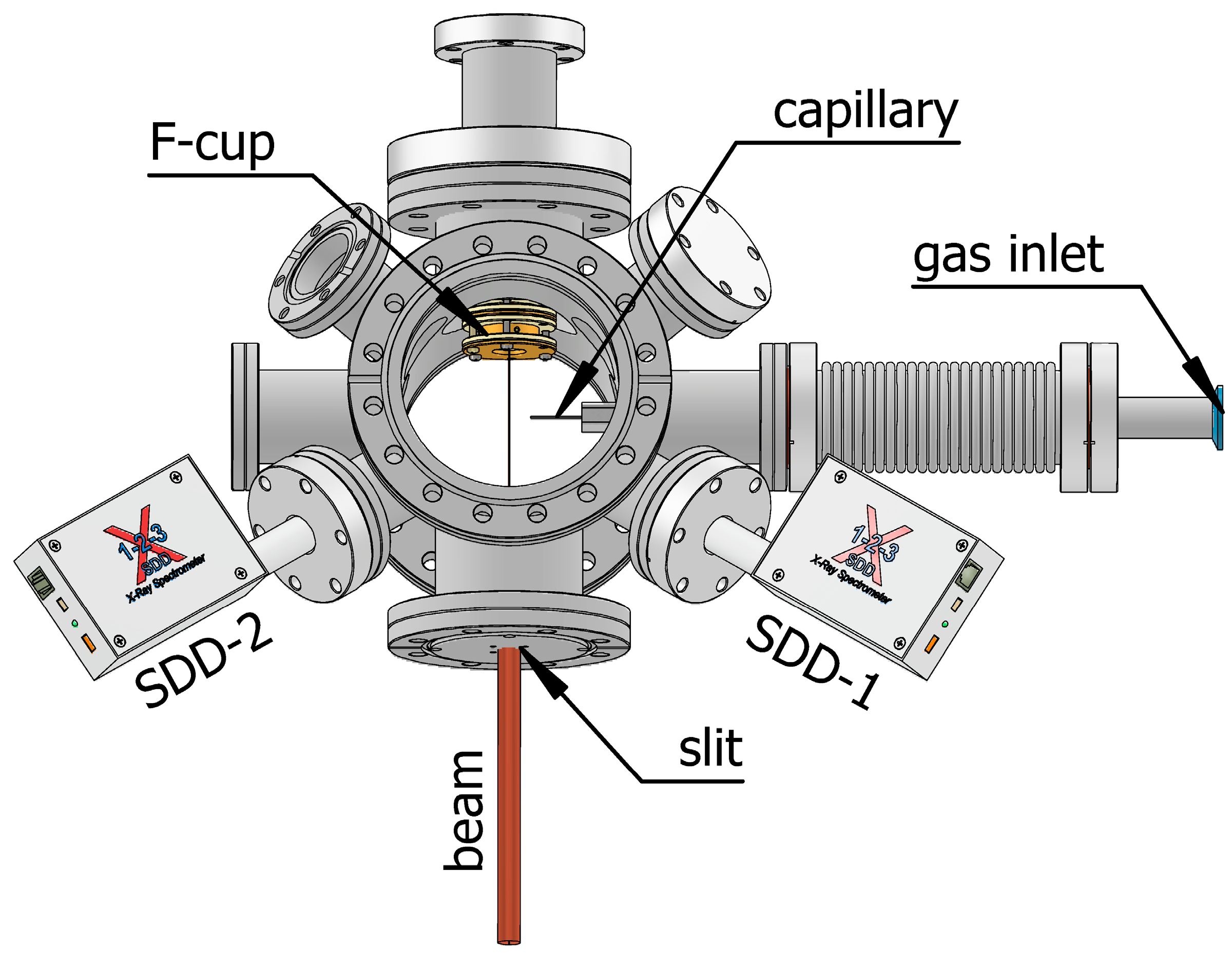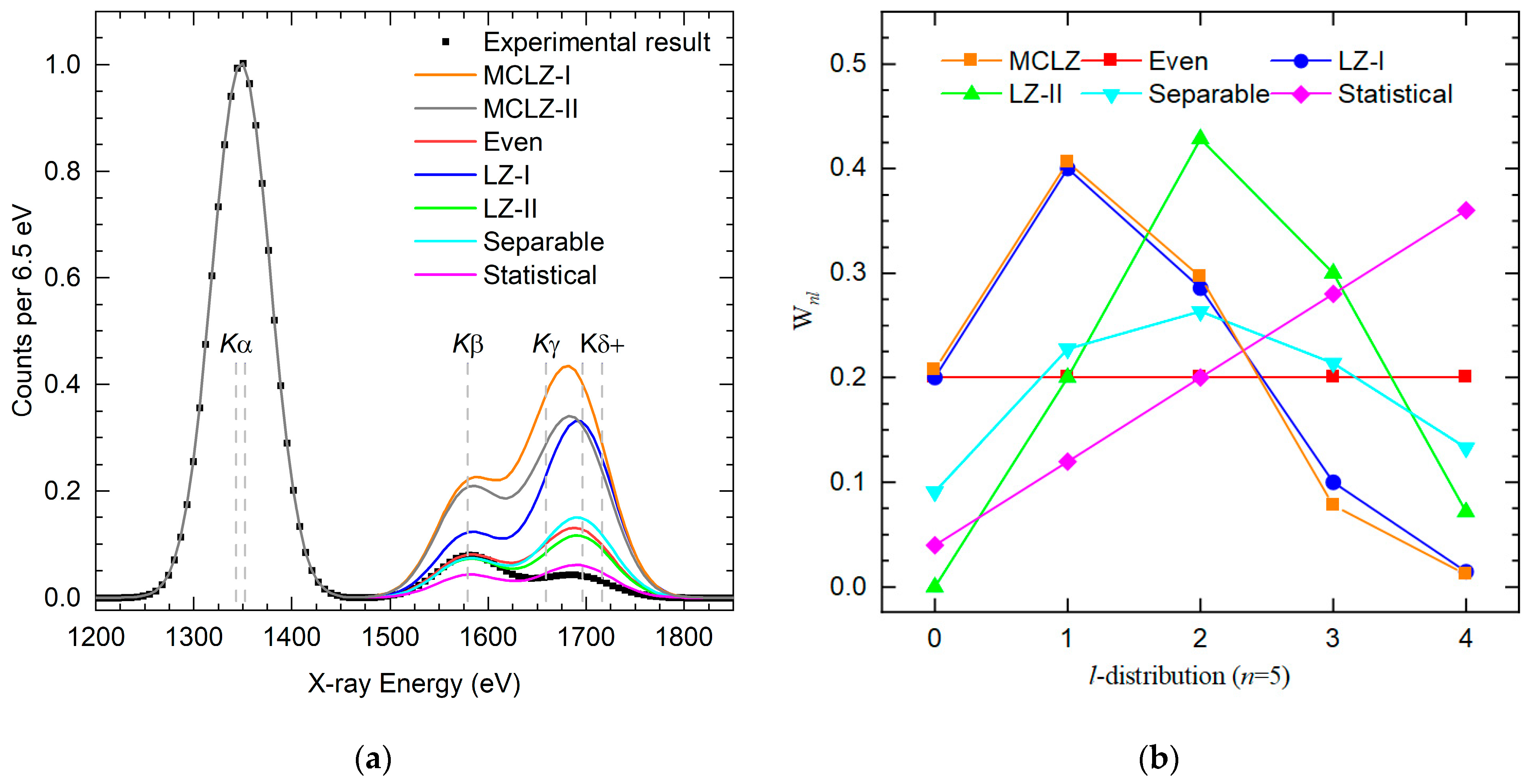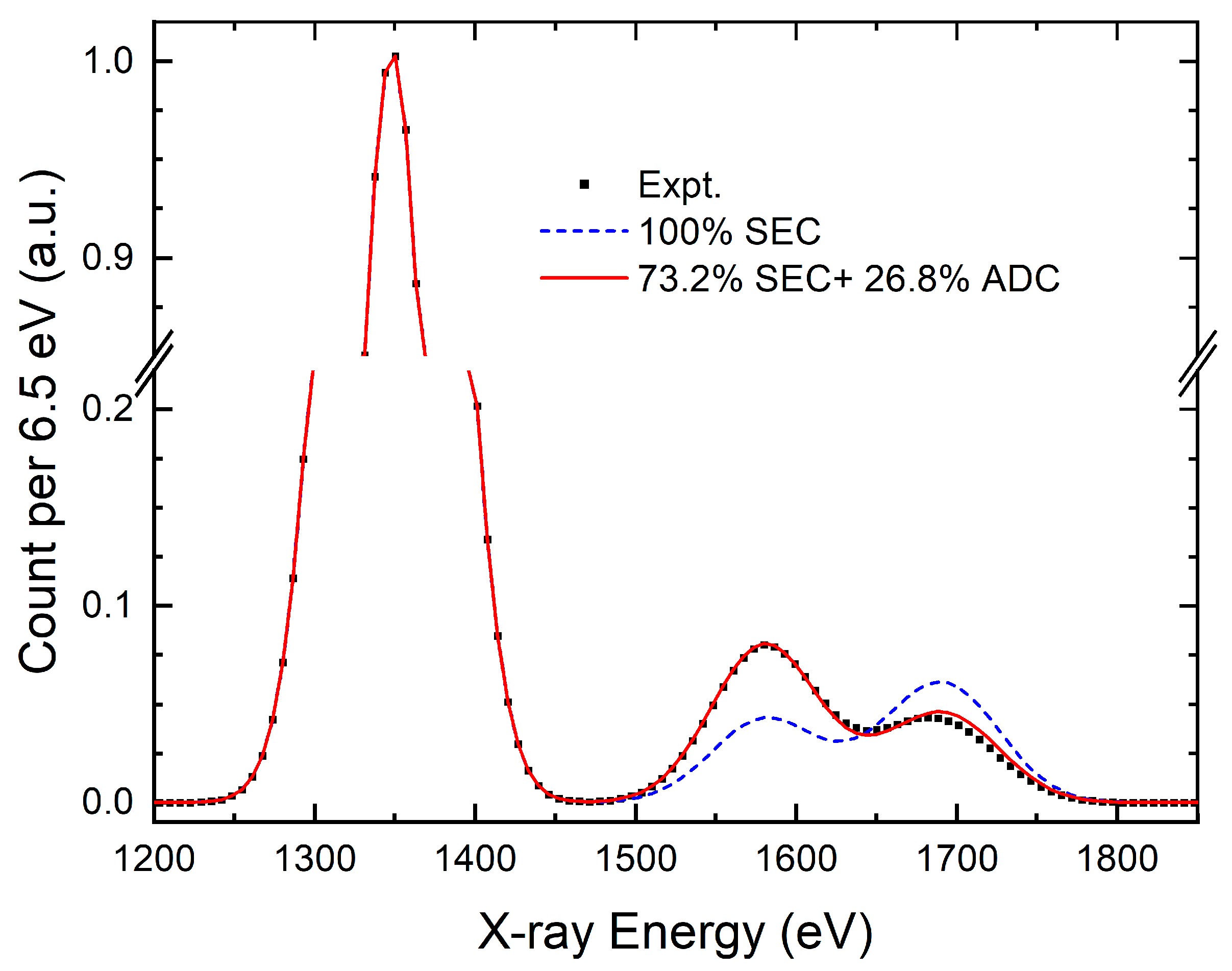The Laboratory Measurement of the Line Ratios in X-Ray Emission Resulting from the Charge Exchange Between Mg11+ and Helium
Abstract
1. Introduction
2. Experiment
3. Results and Discussion
4. Conclusions and Outlook
Author Contributions
Funding
Data Availability Statement
Acknowledgments
Conflicts of Interest
References
- Lisse, C.M.; Dennerl, K.; Englhauser, J.; Harden, M.; Marshall, F.E.; Mumma, M.J.; Petre, R.; Pye, J.P.; Ricketts, M.J.; Schmitt, J.; et al. Discovery of X-ray and Extreme Ultraviolet Emission from Comet C/Hyakutake 1996 B2. Science 1996, 274, 205–209. [Google Scholar] [CrossRef]
- Cravens, T.E. Comet Hyakutake X-ray source: Charge transfer of solar wind heavy ions. Geophys. Res. Lett. 1997, 24, 105–108. [Google Scholar] [CrossRef]
- Beiersdorfer, P.; Boyce, K.R.; Brown, G.V.; Chen, H.; Kahn, S.M.; Kelley, R.L.; May, M.; Olson, R.E.; Porter, F.S.; Stahle, C.K.; et al. Laboratory Simulation of Charge Exchange-Produced X-ray Emission from Comets. Science 2003, 300, 1558–1559. [Google Scholar] [CrossRef] [PubMed]
- Cravens, T.E. X-ray Emission from Comets. Science 2002, 296, 1042–1045. [Google Scholar] [CrossRef]
- Cravens, T.E.; Howell, E.; Waite, J.H., Jr.; Gladstone, G.R. Auroral oxygen precipitation at Jupiter. J. Geophys. Res. Space Phys. 1995, 100, 17153–17161. [Google Scholar] [CrossRef]
- Cox, D.P. Modeling the Local Bubble; Springer: Berlin/Heidelberg, Germany, 1998; pp. 121–131. [Google Scholar]
- Cravens, T.E. Heliospheric X-ray Emission Associated with Charge Transfer of the Solar Wind with Interstellar Neutrals. Astrophys. J. 2000, 532, L153–L156. [Google Scholar] [CrossRef]
- Cumbee, R.S.; Henley, D.B.; Stancil, P.C.; Shelton, R.L.; Nolte, J.L.; Wu, Y.; Schultz, D.R. Can Charge Exchange Explain Anomalous Soft X-Ray Emission in the Cygnus Loop? Astrophys. J. Lett. 2014, 787, L31. [Google Scholar] [CrossRef]
- Katsuda, S.; Tsunemi, H.; Mori, K.; Uchida, H.; Kosugi, H.; Kimura, M.; Nakajima, H.; Takakura, S.; Petre, R.; Hewitt, J.W.; et al. Possible Charge-Exchange X-Ray Emission in the Cygnus Loop Detected With suzaku. Astrophys. J. 2011, 730, 24. [Google Scholar] [CrossRef]
- Fabian, A.C.; Sanders, J.S.; Williams, R.J.R.; Lazarian, A.; Ferland, G.J.; Johnstone, R.M. The energy source of the filaments around the giant galaxy NGC 1275. Mon. Not. R. Astron. Soc. 2011, 417, 172–177. [Google Scholar] [CrossRef]
- Olson, R.E.; Salop, A. Electron transfer between multicharged ions and neutral species. Phys. Rev. A 1976, 14, 579–585. [Google Scholar] [CrossRef]
- Janev, R.K.; Winter, H. State-selective electron capture in atom-highly charged ion collisions. Phys. Rep. 1985, 117, 265–387. [Google Scholar] [CrossRef]
- Fritsch, W.; Lin, C.D. Atomic-orbital-expansion studies of electron transfer in bare-nucleus Z (Z = 2,4-8)-hydrogen-atom collisions. Phys. Rev. A 1984, 29, 3039–3051. [Google Scholar] [CrossRef]
- Kimura, M.; Lane, N.F. The Low-Energy, Heavy-Particle Collisions—A Close-Coupling Treatment. In Advances in Atomic, Molecular, and Optical Physics; Bates, S.D., Bederson, B., Eds.; Academic Press: Cambridge, MA, USA, 1989; Volume 26, pp. 79–160. [Google Scholar] [CrossRef]
- Leung, A.C.K.; Kirchner, T. Analysis of x-ray emission spectra in charge-exchange collisions of C6+ with He and H2. Phys. Rev. A 2016, 93, 052710. [Google Scholar] [CrossRef]
- Liu, C.H.; Wang, J.G.; Janev, R.K. Spin-resolved state-selective electron capture in C5+-H collisions. J. Phys. B At. Mol. Opt. Phys. 2016, 49, 175202. [Google Scholar] [CrossRef]
- Bliman, S.; Cornille, M.; Langereis, A.; Nordgren, J.; Bruch, R.; Phaneuf, R.; Swenson, J.; Schneider, D. Soft X-ray and Auger electron spectroscopy of single and double electron capture processes in slow Ne8++He collisions. Rev. Sci. Instrum. 1997, 68, 1080–1082. [Google Scholar] [CrossRef]
- Bodewits, D.; Hoekstra, R. Electron capture in collisions between O6+ ions and H2O molecules. Phys. Rev. A 2007, 76, 032703. [Google Scholar] [CrossRef]
- Vernhet, D.; Chetioui, A.; Wohrer, K.; Rozet, J.P.; Piquemal, P.; Hitz, D.; Dousson, S.; Salin, A.; Stephan, C. Alignment of Ne8+ n 1P states produced by collisions of Ne9 with H2 at 4 keV/amu. Phys. Rev. A 1985, 32, 1256–1259. [Google Scholar] [CrossRef]
- Wang, W.; Shao, C.J.; Yang, Y.; Yu, D.Y.; Xue, Y.L.; Cai, X.H. A wide-band, high-resolution vacuum flat crystal spectrometer for LEAF facility. J. Instrum. 2023, 18, T02002. [Google Scholar] [CrossRef]
- Beiersdorfer, P.; Olson, R.E.; Brown, G.V.; Chen, H.; Harris, C.L.; Neill, P.A.; Schweikhard, L.; Utter, S.B.; Widmann, K. X-Ray Emission Following Low-Energy Charge Exchange Collisions of Highly Charged Ions. Phys. Rev. Lett. 2000, 85, 5090–5093. [Google Scholar] [CrossRef]
- Allen, F.I.; Biedermann, C.; Radtke, R.; Fussmann, G.; Fritzsche, S. Energy dependence of angular momentum capture states in charge exchange collisions between slow highly charged argon ions and argon neutrals. Phys. Rev. A 2008, 78, 032705. [Google Scholar] [CrossRef]
- Defay, X.; Morgan, K.; McCammon, D.; Wulf, D.; Andrianarijaona, V.M.; Fogle, M.; Seely, D.G.; Draganić, I.N.; Havener, C.C. X-ray emission measurements following charge exchange between C6 and He. Phys. Rev. A 2013, 88, 052702. [Google Scholar] [CrossRef] [PubMed]
- Betancourt-Martinez, G.L.; Beiersdorfer, P.; Brown, G.V.; Kelley, R.L.; Kilbourne, C.A.; Koutroumpa, D.; Leutenegger, M.A.; Porter, F.S. Observation of highly disparate K-shell x-ray spectra produced by charge exchange with bare mid-Z ions. Phys. Rev. A 2014, 90, 052723. [Google Scholar] [CrossRef]
- Fogle, M.; Wulf, D.; Morgan, K.; McCammon, D.; Seely, D.G.; Draganić, I.N.; Havener, C.C. X-ray-emission measurements following charge exchange between C6+ and H2. Phys. Rev. A 2014, 89, 042705. [Google Scholar] [CrossRef]
- Seely, D.G.; Andrianarijaona, V.M.; Wulf, D.; Morgan, K.; McCammon, D.; Fogle, M.; Stancil, P.C.; Zhang, R.T.; Havener, C.C. Line ratios for soft-x-ray emission following charge exchange between O8+ and Kr. Phys. Rev. A 2017, 95, 052704. [Google Scholar] [CrossRef]
- Huber, B.A.; Kahlert, H.J. State-selective electron capture by Ar2+ (3P, 1D, 1S) ions in He, Ne and Kr. J. Phys. B At. Mol. Phys. 1983, 16, 4655. [Google Scholar] [CrossRef]
- Okuno, K.; Tawara, H.; Iwai, T.; Kaneko, Y.; Kimura, M.; Kobayashi, N.; Matsumoto, A.; Ohtani, S.; Takagi, S.; Tsurubuchi, S. Energy-spectroscopic studies of electron-capture processes by low-energy, highly stripped C, N, and O ions from He. Phys. Rev. A 1983, 28, 127–134. [Google Scholar] [CrossRef]
- Schmeissner, C.; Cocke, C.L.; Mann, R.; Meyerhof, W. Energy-gain spectroscopy studies of electron capture from helium by slow multiply charged neon ions. Phys. Rev. A 1984, 30, 1661–1671. [Google Scholar] [CrossRef]
- Seredyuk, B.; McCullough, R.W.; Gilbody, H.B. One-electron capture mechanisms in collisions of He-like O and C ions with molecules of astrophysical interest. Phys. Rev. A 2005, 72, 022710. [Google Scholar] [CrossRef]
- Abdallah, M.A.; Wolff, W.; Wolf, H.E.; Kamber, E.Y.; Stöckli, M.; Cocke, C.L. Single and double electron capture from He by Ar16+ studied using cold-target recoil-ion momentum spectroscopy. Phys. Rev. A 1998, 58, 2911–2919. [Google Scholar] [CrossRef]
- Kamber, E.Y.; Abdallah, M.A.; Cocke, C.L.; Stöckli, M. Longitudinal and Transverse Recoil Electron Capture Processes in 0.5–50 keV/u C5+–He Collisions. Phys. Scr. 1999, T80, 367. [Google Scholar] [CrossRef]
- Dörner, R.; Mergel, V.; Jagutzki, O.; Spielberger, L.; Ullrich, J.; Moshammer, R.; Schmidt-Böcking, H. Cold Target Recoil Ion Momentum Spectroscopy: A ‘momentum microscope’ to view atomic collision dynamics. Phys. Rep. 2000, 330, 95–192. [Google Scholar] [CrossRef]
- Fléchard, X.; Harel, C.; Jouin, H.; Pons, B.; Adoui, L.; Frémont, F.; Cassimi, A.; Hennecart, D. Single- and double-electron capture in low-energy Ne10+-He collisions. J. Phys. B At. Mol. Opt. Phys. 2001, 34, 2759–2779. [Google Scholar] [CrossRef]
- Hasan, A.A.; Eissa, F.; Ali, R.; Schultz, D.R.; Stancil, P.C. State-selective Charge Transfer Studies Relevant to Solar Wind–Comet Interactions. Astrophys. J. 2001, 560, L201–L205. [Google Scholar] [CrossRef][Green Version]
- Fischer, D.; Feuerstein, B.; DuBois, R.D.; Moshammer, R.; López-Urrutia, J.R.C.; Draganic, I.; Lörch, H.; Perumal, A.N.; Ullrich, J. State-resolved measurements of single-electron capture in slow Ne7+- and Ne8+-helium collisions. J. Phys. B At. Mol. Opt. Phys. 2002, 35, 1369. [Google Scholar] [CrossRef]
- Ullrich, J.; Moshammer, R.; Dorn, A.; Dörner, R.; Schmidt, L.P.H.; Schmidt-Böcking, H. Recoil-ion and electron momentum spectroscopy: Reaction-microscopes. Rep. Prog. Phys. 2003, 66, 1463–1545. [Google Scholar] [CrossRef]
- Ali, R.; Beiersdorfer, P.; Harris, C.L.; Neill, P.A. Charge-exchange X-ray spectra: Evidence for significant contributions from radiative decays of doubly excited states. Phys. Rev. A 2016, 93, 012711. [Google Scholar] [CrossRef]
- Zhang, R.T.; Zhu, X.L.; Li, X.Y.; Liu, L.; Zhang, S.F.; Feng, W.T.; Guo, D.L.; Gao, Y.; Zhao, D.M.; Wang, J.G.; et al. Single-electron capture in 3-keV/uAr8+-He collisions. Phys. Rev. A 2017, 95, 042702. [Google Scholar] [CrossRef]
- Xu, J.W.; Xu, C.X.; Zhang, R.T.; Zhu, X.L.; Feng, W.T.; Gu, L.; Liang, G.Y.; Guo, D.L.; Gao, Y.; Zhao, D.M.; et al. Measurement of n-resolved State-selective Charge Exchange in Ne Collision with He and H. Astrophys. J. Suppl. Ser. 2021, 253, 13. [Google Scholar] [CrossRef]
- Xia, Z.H.; Ren, B.; Zhang, R.T.; Wei, L.; Han, J.; Meng, T.; Wang, J.; Ma, P.; Zhang, Y.; Tu, B.; et al. Measurement of n- and l-resolved State-selective Charge Exchange in Ar8+ Collision with He. Astrophys. J. 2022, 933, 207. [Google Scholar] [CrossRef]
- Ma, P.F.; Yin, H.; Ren, B.; Meng, T.; Wang, J.; Wu, Y.; Tan, X.; Zhang, Y.; Qi, Y.; Yao, K.; et al. Laboratory Studies on Absolute n-resolved Charge-exchange Cross Sections and Modeling X-Ray Emissions for Ne8+ Colliding with H2 and He. Astrophys. J. 2025, 978, 6. [Google Scholar] [CrossRef]
- Moradmand, A.; El Ghazaly, M.O.A.; Mahaptra, D.P.; Chutjian, A. Measurement of Absolute Single and Double Charge Exchange Cross Sections for Si (7–10)+ at 0.88–2.50 KeV/u Impacting He and H2. Astrophys. J. Suppl. Ser. 2018, 234, 14. [Google Scholar] [CrossRef]
- Liu, J.; Mao, S.; Wang, Q.D. Charge-exchange X-ray emission of M82: Ka triplets of OVII, Ne IX and Mg XI. Mon. Not. R. Astron. Soc. Lett. 2011, 415, L64–L68. [Google Scholar] [CrossRef]
- Lyons, D.; Cumbee, R.S.; Stancil, P.C. Charge Exchange of Highly Charged Ne and Mg Ions with H and He. Astrophys. J. Suppl. Ser. 2017, 232, 27. [Google Scholar] [CrossRef]
- Qian, C.; Sun, L.T.; Lu, W.; Jia, Z.H.; Yang, T.J.; Zhu, L.; Zheng, S.J.; Wang, X.D.; Fang, X.; Li, L.B.; et al. High Performance 18 GHz ECR Ion Sources Development. J. Phys. Conf. Ser. 2022, 2244, 012024. [Google Scholar] [CrossRef]
- Lamour, E.; Prigent, C.; Ramillon, J.M.; Rozet, J.P.; Steydli, S.; Trassinelli, M.; Vernhet, D. High-resolution x-ray spectroscopy to probe quantum dynamics in collisions of Ar17+,18+ ions with atoms and solids, towards clusters. J. Phys. B At. Mol. Opt. Phys. 2015, 48, 144016. [Google Scholar] [CrossRef]
- Gu, M.F. The flexible atomic code. Can. J. Phys. 2008, 86, 675–689. [Google Scholar] [CrossRef]
- Mullen, P.D.; Cumbee, R.S.; Lyons, D.; Stancil, P.C. Charge Exchange-Induced X-Ray Emission of Fe XXV and Fe XXVI via a Streamlined Model. Astrophys. J. Suppl. Ser. 2016, 224, 31. [Google Scholar] [CrossRef]




| Line Ratios | Experiment | Theory | ||
|---|---|---|---|---|
| SDD (No. 1) | SDD (No. 2) | MCLZ-II | Statistical | |
| I(Kβ)/I(Kα) | 0.091 ± 0.003 | 0.095 ± 0.003 | 0.233 | 0.047 |
| I(Kγ)/I(Kα) | 0.021 ± 0.001 | 0.022 ± 0.001 | 0.250 | 0.019 |
| I(Kδ+)/I(Kα) | 0.038 ± 0.001 | 0.037 ± 0.002 | 0.311 | 0.057 |
| Hardness ratio | 0.150 ± 0.005 | 0.154 ± 0.006 | 0.794 | 0.122 |
Disclaimer/Publisher’s Note: The statements, opinions and data contained in all publications are solely those of the individual author(s) and contributor(s) and not of MDPI and/or the editor(s). MDPI and/or the editor(s) disclaim responsibility for any injury to people or property resulting from any ideas, methods, instructions or products referred to in the content. |
© 2025 by the authors. Licensee MDPI, Basel, Switzerland. This article is an open access article distributed under the terms and conditions of the Creative Commons Attribution (CC BY) license (https://creativecommons.org/licenses/by/4.0/).
Share and Cite
Shu, K.; Shao, C.; Zhang, S.; Zhang, R.; Qian, C.; Xue, Y.; Zhang, M.; Tian, J.; Wang, Z.; Zhu, X.; et al. The Laboratory Measurement of the Line Ratios in X-Ray Emission Resulting from the Charge Exchange Between Mg11+ and Helium. Atoms 2025, 13, 34. https://doi.org/10.3390/atoms13040034
Shu K, Shao C, Zhang S, Zhang R, Qian C, Xue Y, Zhang M, Tian J, Wang Z, Zhu X, et al. The Laboratory Measurement of the Line Ratios in X-Ray Emission Resulting from the Charge Exchange Between Mg11+ and Helium. Atoms. 2025; 13(4):34. https://doi.org/10.3390/atoms13040034
Chicago/Turabian StyleShu, Kebao, Caojie Shao, Shuo Zhang, Ruitian Zhang, Cheng Qian, Yingli Xue, Mingwu Zhang, Jinlei Tian, Zhenqiang Wang, Xiaolong Zhu, and et al. 2025. "The Laboratory Measurement of the Line Ratios in X-Ray Emission Resulting from the Charge Exchange Between Mg11+ and Helium" Atoms 13, no. 4: 34. https://doi.org/10.3390/atoms13040034
APA StyleShu, K., Shao, C., Zhang, S., Zhang, R., Qian, C., Xue, Y., Zhang, M., Tian, J., Wang, Z., Zhu, X., Sun, L., Ran, J., & Yu, D. (2025). The Laboratory Measurement of the Line Ratios in X-Ray Emission Resulting from the Charge Exchange Between Mg11+ and Helium. Atoms, 13(4), 34. https://doi.org/10.3390/atoms13040034









